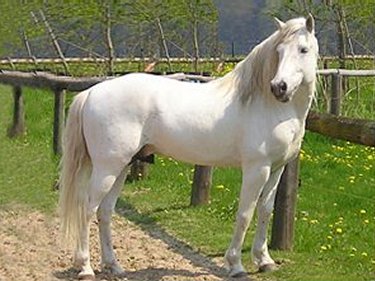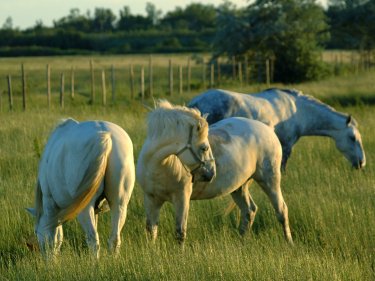|
The French government officially set standards for the Camargue horse in 1976
and registered the main Camargue breeders in order to preserve purity in the
breed. The Camargue horse was then officially recognized by the National Stud
Farms in 1978 and a stud book was set up.

Registrations for identifying Camargue horses are 1) Camargue: Horses
registered in the stud book, foaled and identified in Camargue area, branded
before weaning, and from a manade (a small, semi-feral herd structure). The
berceau or cradle of the breed is strictly defined, and consists of 45
communes in the départements of Bouches-du-Rhône, Gard and Hérault.; 2)
Camargue hors manade: Horses registered in the stud book, foaled and
identified in Camargue area, and not from a manade.; 3) Camargue hors
berceau: Horses registered in the stud book, foaled and identified outside
of the Camargue area. There exists a strong sense of regionalism in Camargue
area, so registration for the horses is treated similarly to an Appellation
d'origine contrôlée.; 4) The Cavallo del Delta: The Camargue horse was
introduced in the 1970s to the Po delta in Italy, where under the name
"Cavallo del Delta" it is treated as an indigenous breed. In 2011 the
registered population numbered 163.
Births in the wild occur from April until July. The horses are gathered up at the age of three and trained. One of the techniques which is taught is neck reining, allowing the rider to keep only one hand on the reins. Most of the farms or manades where Camarques are bred, only males are broken in and the mares are bred for reproduction. Breeders of the Camargue belong to the Association des Eleveurs de Chevaux de Race Camargue (Breeders Association for the Race of the Camargue Horse ). The Camargue Horse is also known as "horse of the sea."
ORIGINS
The Camargue horse is one of the oldest breeds of horses known. It is indigenous of the harsh wetlands of the Camargue region of Southern France where it has resided as far back as prehistoric times. Researchers believe that the Camargue horse is a descendent from the ancient Solutre horse. Archeological evidence of this has been found to a considerable extent in the Burgundy region of France. The Camargue horse is also closely related to Spanish breeds from the northern part of the peninsula.
Camargue horses live almost free within the marshes and saltworts of throughout most the year. They are rounded up annually for health inspections, branding, and gelding of unsuitable stock. In 1970, the Parc Naturel Régional de Camargue (Regional Natural Park of the Camargue) along the shoreline of Camargue was established as a regional park and natural reserve. The park covers over 500 square miles.
PHYSICAL FEATURES / PHYSIQUE
Camarque horses are very rustic little horses that are born black or dark
brown. However, as they grow to adulthood, their coat lightens until it is
pale grey or white. They have a coarse, heavy, oriental-type square heads
of primitive horses. However, the influence of Arabian, Barb and
Thoroughbred blood can also be seen. They average from 13.1 to 14.2 hands
high, and have a short body with straight upright shoulders, deep chest,
extremely hardy legs with clean joints, long forearms, very good hooves and
a full mane and tail. The Camargue horse weighs from 660 to 880 pounds. Its
eyes are large and expressive, and its ears are are broad and short. Life
expectancy is from 20 to 25 years.
TEMPERAMENT
The Camargue horse has a very calm temperament, agility, and stamina. It is generally self sufficient animals and do not require much from their keepers.

USES / ASSETS
Camargue horses are excellent mounts. They are the traditional mount of the
gardians (Camargue cowboys). They can easily walk for long distances,
withstanding extreme conditions and going without food for a long period of
time. The horse's remarkable temperament, agility, and endurance has resulted
in its being used for equestrian games, dressage and long distance riding.
STATUS
Because of wildlife sanctuaries, the Camargue has reclaimed its homeland.
In addition, the Camargue gardians and breeders are aiding in preserving the
breed. By exhibiting breed's skills at local festivals, people are becoming
aware of the breed.
|

